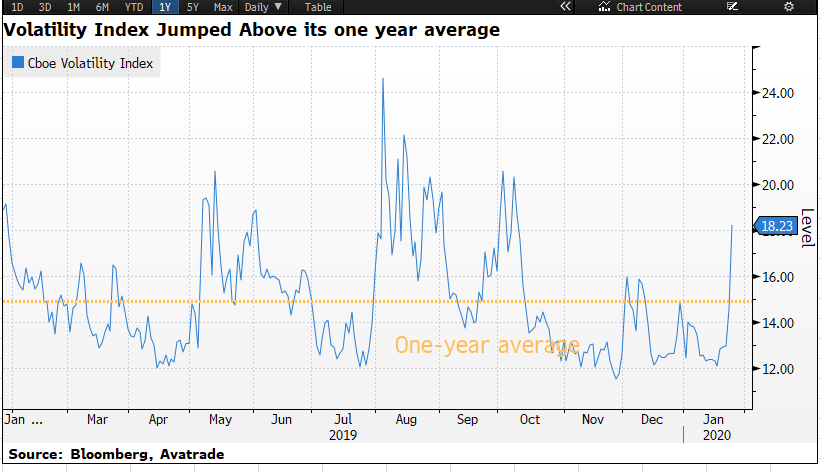European markets have set aside some of the concerns about Coronavirus. Speculators are back in town and ready to support the markets. For them, the current sell-off is an opportunity. Having said this, the theme isn’t the same across global markets as they are still under the influence of this virus.
Asian markets suffered heavy losses as the efforts continued to curb the spread of Coronavirus. Investors are not sure how to measure the economic damage of this virus, and this very fact makes them nervous. The fear of unknown pushed the Japnese equity markets towards their worst two days losses—something which we have not seen since August last year.
Looking at the global markets and risk sentiment, we do not think that investors are going to be fully in love with riskier assets until or unless we hear the news that the virus situation has improved. This is the reason the volatility index, the VIX, has jumped beyond its one year average while the equity indices tumbled. The one year average for the index sits at 14.94 while it closed at 18.23 yesterday.
Apple: Watch The After Hour Liquidity
As for the earning season, Apple’s earnings report has the potential to set off plenty of market volatility. The tech giant is expected to report its’ earnings after the US market. Apple plans to increase its iPhone output by 10% during the first half of 2020 or in other words, by 80 million units. Investors are going to focus on their webcast carefully and they will guage the disruption caused due to the Coronavirus. This is because all iPhones are produced in China. If the company confirms that the current situation is nothing but a short term hurdle then the market participants are going to take that as a sign of confidence.
Investors should keep in mind that liquidity isn’t abundant during the after-hour trading and anything which comes out of blue, like the revenue warning by Apple in 2019, it could inspire a flash crash.
The information is purely for education purposes only and cannot be perceived as an advise.
Recommended Content
Editors’ Picks
AUD/USD could extend the recovery to 0.6500 and above

The enhanced risk appetite and the weakening of the Greenback enabled AUD/USD to build on the promising start to the week and trade closer to the key barrier at 0.6500 the figure ahead of key inflation figures in Australia.
EUR/USD now refocuses on the 200-day SMA

EUR/USD extended its positive momentum and rose above the 1.0700 yardstick, driven by the intense PMI-led retracement in the US Dollar as well as a prevailing risk-friendly environment in the FX universe.
Gold struggles around $2,325 despite broad US Dollar’s weakness

Gold reversed its direction and rose to the $2,320 area, erasing a large portion of its daily losses in the process. The benchmark 10-year US Treasury bond yield stays in the red below 4.6% following the weak US PMI data and supports XAU/USD.
Bitcoin price makes run for previous cycle highs as Morgan Stanley pushes BTC ETF exposure

Bitcoin (BTC) price strength continues to grow, three days after the fourth halving. Optimism continues to abound in the market as Bitcoiners envision a reclamation of previous cycle highs.
US versus the Eurozone: Inflation divergence causes monetary desynchronization

Historically there is a very close correlation between changes in US Treasury yields and German Bund yields. This is relevant at the current juncture, considering that the recent hawkish twist in the tone of the Federal Reserve might continue to push US long-term interest rates higher and put upward pressure on bond yields in the Eurozone.
